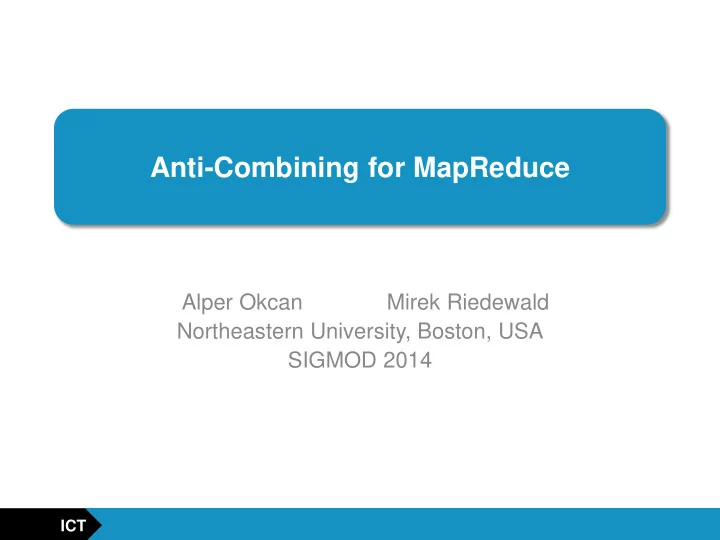

Anti-Combining for MapReduce Alper Okcan Mirek Riedewald Northeastern University, Boston, USA SIGMOD 2014 ICT
MapReduce Overview Shuffle ICT
Shuffle is always the bottleneck of a MR job execution • large amounts of data are grouped, sorted, and moved across the network • data transfer is inherent to enable parallel execution • Network links and switches are in fact limited Reducing network load is essential for increasing throughput in highly utilized environments ICT
The methods of reducing network load Methods Advantages Disadvantages Limitation to applications; Combiner User-defined Efficiency; Overheads for compression and Compression The reduction of data decompression; Same pattern; Make good use of devices’ Active Storage complex computation ICT
Motivation • Two design goals – Simple encoding/decoding functions • CPU cost • buffer space – Fine-grained adaptive optimization • the choice of encode – driven by the data ICT
MapReduce Overview with Query Suggestion Example The Query-Suggestion problem We are given a log of search queries. For any string P that occurred as a prefix of some query in the log, pre-compute the five most frequent queries in the log starting with prefix P ICT
The Problem of current Query Suggestion execution • For a search query of length n – the Map function will generate n output records – each Map function call's output is quadratic in its input size • each output record contains the query itself • Combiner – The large number of distinct query strings – a Combiner might not be applicable at all ICT
Eager Sharing Strategy • EagerSH Map Phase first executes the original Map on the given input record Then groups the original Map's output by value and partition number For each group, a single record is emitted ICT
Eager Sharing Strategy • EagerSH Reduce Phase EagerSH 's Reduce only receives three encoded records, in this case all those with key “m“, EagerSH 's Reduce scans through all records with that key and inserts into Shared the corresponding key/value combinations for all keys encoded in the value component. reduce task 1 receives all the records with the keys assigned to it by the Partitioner, in key order. It then calls Reduce three times, first for key “m ", followed by”man ", and finally “mango " in the example. ICT
EagerSH 's Reduce Function ICT
Anti-Combining Design — Lazy Sharing Strategy • To decrease mapper output size – a Combiner • requires records with the same key – EagerSH • requires records with the same value – traditional compression techniques • require some form of redundancy among the keys and values When all keys and values in the output of a Map call are unique, how to decrease mapper output size ICT
Anti-Combining Design — Lazy Sharing Strategy EagerSH LazySH LazySH: transfers the Map input record to all reduce tasks ICT
Lazy Sharing Strategy • LazySH Map Phase First computes the output of the original Map call for input record then finds the minimal key for each reduce task, i.e., partition record I is emitted for each of these minimal keys ICT
Analysis of an example • A real query, and its length is n – If the Partitioner assigns all its prefixes to the same reduce task • Original program – 1+n + 2+n + ….. + n+n = n(1+n)/2 + n*n • EagerSH – 1 + (2 + 3 + ….. + n) + n = n(1+n)/2 + n • LazySH – 1+n ICT
Lazy Sharing Strategy • LazySH Reduce Phase The reduce tasks of LazySH receive Map input, not output, therefore decoding in the reducer requires re-execution of the original Map function ICT
Anti-Combining Design — ENABLING ADAPTIVE RUNTIME OPTIMIZATION first executes the original program's Map function on input record (key, val) (through the o_mapper object) then partitions the output compute the total cost of re- executing o mapper.map and getPartition to determine EagerSH or LazySH ICT
Anti-Combining Design — ENABLING ADAPTIVE RUNTIME OPTIMIZATION ICT
Evaluation • Platform – a 12-machine cluster running Hadoop 1.0.3 – Each machine • a single quad-core Xeon 2.4GHz processor • 8MB cache • 8GB RAM • two 250 GB 7.2K RPM SATA hard disks • Data sets QLog 140 million real queries 4.3GB ClueWeb09 a real data set containing the first English segment of a web 7GB crawl Cloud a real data set containing extended cloud reports 28.8GB from ships and land stations RandomText a synthetic data set containing randomly generated text records 360GB ICT
Query Suggestion I • the Query-Suggestion problem on QLog and explore the eect of the choice of Partitioner by comparing three alternatives ICT
Query Suggestion II ICT
Effect on Disk I/O and CPU • The cost breakdown for total disk read/write and total CPU time of the Query Suggestion – “ -CB ” and “ -CP ” means Combiner and compression, respectively. ICT
CPU Intensive Workloads • the performance of Anti-Combining for CPU intensive workloads by adding extra CPU intensive calls to the Map function ICT
Conclusions • Anti-Combining – A novel approach for reducing the amount of data transferred between mappers and reducers – Shifts mapper-side processing to the reducers – Adaptive runtime optimization • Applicable 的问题 ICT
Recommend
More recommend